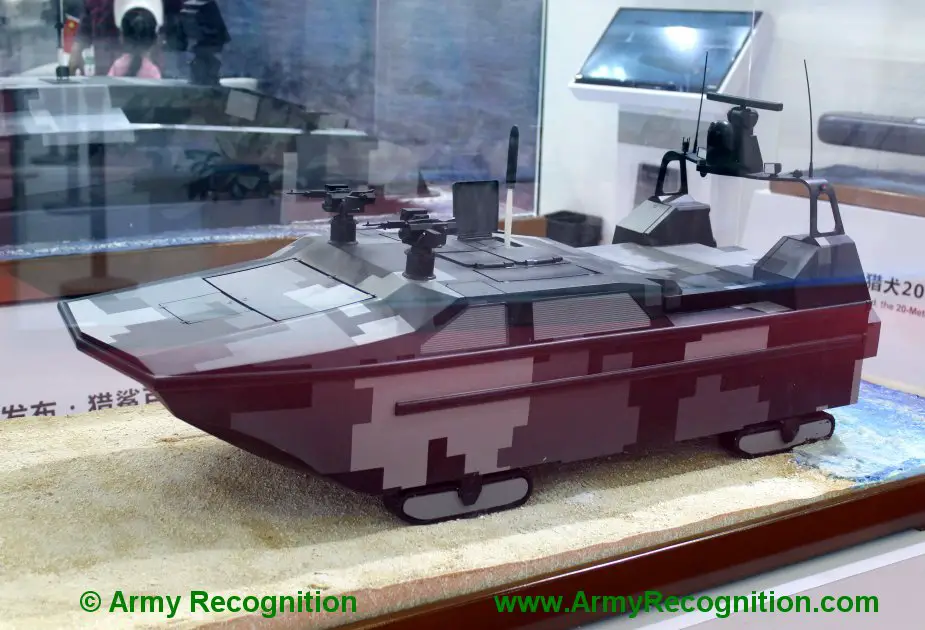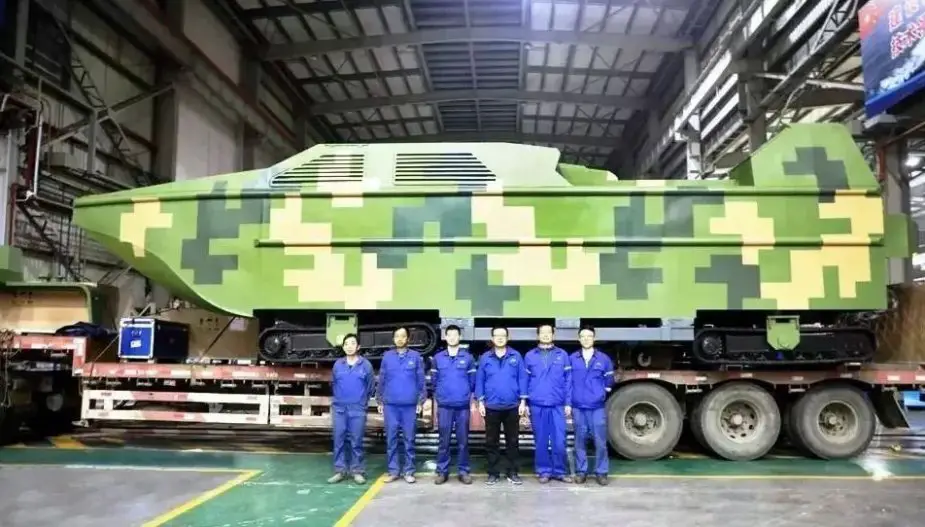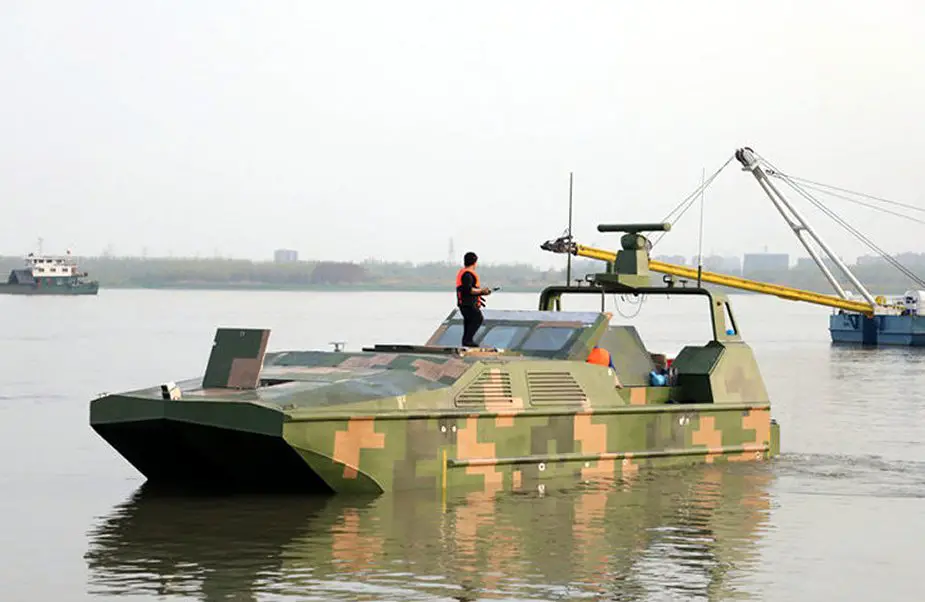Breaking news
China builds first armed amphibious tracked drone boat.
China has built the world's first armed amphibious drone boat which military analysts said could be used in land assault operations and is capable of forming a combat triad with aerial drones and other drone ships, Liu Xuanzun wrote in the Global Times.

The world's first armed amphibious drone boat "Marine Lizard" was successfully delivered on April 8, 2019, by China Shipbuilding Industry Corporation (Picture source: Army Recognition)
Built by Wuchang Shipbuilding Industry Group under China Shipbuilding Industry Corporation (CSIC), the drone ship, named Marine Lizard, successfully passed delivery checks and left factory on April 8 in Wuhan, capital of Central China's Hubei Province, CSIC revealed on Friday via Sina Weibo.
In ship form, the 12-meter-long Marine Lizard is a trimaran propelled by a diesel-powered hydrojet and can reach a maximum speed of 50 knots while maintaining stealth. When approaching land, the amphibious drone ship can release four continuous track units hidden under its belly, and travel at 20 kilometers an hour on land, the Hubei Daily reported on Sunday, citing an unnamed company manager who also mentioned that the maximum land speed can be increased if larger track units are installed.

The world's first armed amphibious drone boat "Marine Lizard" was successfully delivered on April 8, 2019, by China Shipbuilding Industry Corporation (Picture source: Wuchang Shipbuilding Industry Group)
The Marine Lizard's payloads include an electro-optical system and a radar system. In the weapon department, it is equipped with two machine guns and a vertical launching system for anti-ship and anti-aircraft missiles, the manager said, noting it can autonomously sail, avoid obstacles and plan routes.
This amphibious drone boat is suitable for island assault operations as a swarm of such drone ships could lead an attack following a first wave of artillery and air strikes, an anonymous military expert told the Global Times on Sunday. Approaching land from the sea is a dangerous task, and the Marine Lizard can take advantage of its unmanned nature to discover enemy positions and provide suppressive fire as troops follow, the expert said.

The world's first armed amphibious drone boat "Marine Lizard" was successfully delivered on April 8, 2019, by China Shipbuilding Industry Corporation (Picture source: Wuchang Shipbuilding Industry Group)
The drone boat is also a great choice for coastal defense. The company manager said it can remain dormant on an uninhabited island for up to eight months before engaging in combat once it receives orders, according to the Hubei Daily report.
Provided with world-class navigation by China's independently developed BeiDou Navigation Satellite System, the Marine Lizard can cooperate with other battle units in an integrated command system, the manager said.

The world's first armed amphibious drone boat "Marine Lizard" was successfully delivered on April 8, 2019, by China Shipbuilding Industry Corporation (Picture source: Wuchang Shipbuilding Industry Group)
The anonymous expert also pointed out the amphibious Marine Lizard can possibly form an unmanned sea-land-air integrated combat system with aerial armed reconnaissance drones and other drone ships, which can engage in combat with great efficiency and low risk of casualties.
Having a maximum operation range of 1,200 kilometers, the Marine Lizard can be remotely controlled via satellites, the company manager said.

Landwasserschlepper of the German army in World War 2 (Picture source: German army)
A German predecessor of the Marine Lizard concept
During World War II, the German army already experienced and operated in very limited number a boat fitted with tracks, called Landwasserschlepper (ground water tracked). Ordered by the Heereswaffenamt in 1935 for use by German Army engineers, the Landwasserschlepper (or LWS) was intended as a lightweight river tug with some capacity to operate on land. Intended to aid river crossing and bridging operations, it was designed by Rheinmetall-Borsig of Düsseldorf. The hull was similar to that of a motor launch, resembling a tracked boat with twin rear-mounted tunnelled propellers and twin rudders. On land, it rode on steel-shod tracks with four bogies per side.
By the autumn of 1940 three prototypes had been completed and were assigned to Tank Detachment 100 as part of Operation Sea Lion. It was intended to use them for pulling ashore unpowered assault barges during the invasion and for towing vehicles across the beaches. They would also have been used to carry supplies directly ashore during the six hours of falling tide when the barges were grounded. This involved towing a Kässbohrer amphibious trailer (capable of transporting 10-20 tons of freight) behind the LWS.
The Landwasserschlepper was demonstrated to General Franz Halder on 2 August 1940 by the Reinhardt Trials Staff on the island of Sylt and, though he was critical of its high silhouette on land, he recognized the overall usefulness of the design. It was proposed to build enough LWSs that each invasion barge could be assigned one or two of them, but difficulties in mass-producing the vehicle prevented implementation of that plan.
Due to protracted development, the Landwasserschlepper did not enter regular service until 1942 and, though it proved useful in both Russia and North Africa, it was produced in only small numbers. In 1944 a completely new design was introduced, the LWS II. This vehicle was based on a Panzer IV tank chassis and featured a small raised armored driver's cabin and a flat rear deck with four fold-down intake and exhaust stacks. Landwasserschlepper remained operational until the end of the war in May 1945.


























